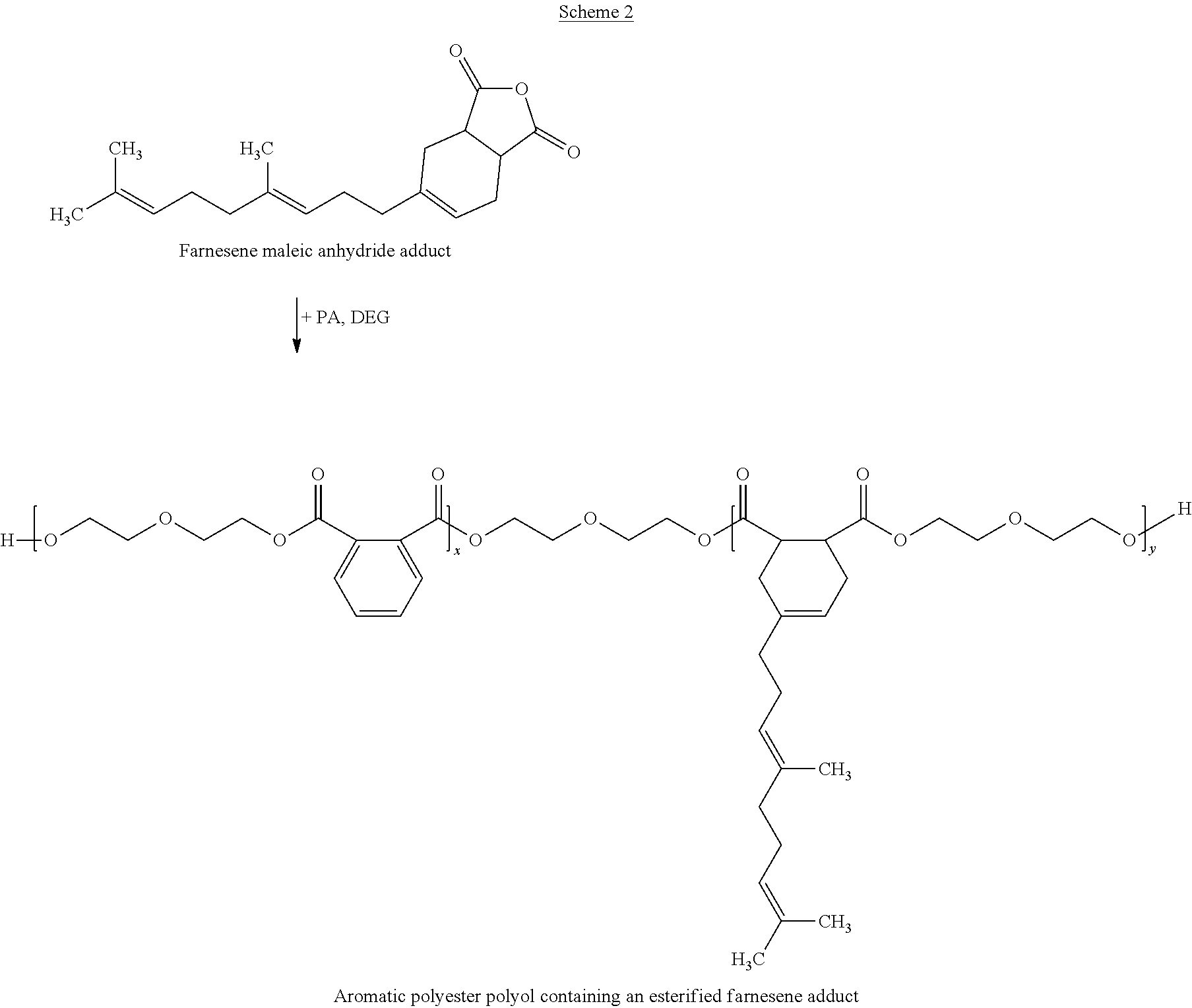Polyester Polyols Containing Diels-Alder or Ene Adducts
a polyol and polyol technology, applied in the direction of polyurea/polyurethane coatings, coatings, etc., can solve the problems of deterioration of foam properties, deterioration of stability of resultant foam formed from the reaction of functionalized natural oils with isocyanates, etc., to achieve k factor foam performance, compressive strength, and superior green strength
- Summary
- Abstract
- Description
- Claims
- Application Information
AI Technical Summary
Benefits of technology
Problems solved by technology
Method used
Image
Examples
example 1
[0114]Polyol 1: 6.4 mols of aromatic diacid, 1.6 moles of maleic anhydride and 14.29 mols of diethylene glycol (DEG) were charged to a reactor affixed with mechanical stirring, nitrogen inlet, packed column, condenser with receiver, and temperature control and then heated to 230° C. under nitrogen sparge. When the acid value (AV) was 3 or below, a transition metal catalyst was added. When the AV was about 1, the hydroxyl value (OHV) was measured and adjusted with DEG to get the target value. This yielded a polyol with 280 mg KOH / g OHV and 0.8 mg KOH / g AV.
example 2
[0115]Polyol 2: 3.4 mols of aromatic diacid, 0.55 moles of Adduct 1 and 7.09 mols of DEG were charged to a reactor affixed with mechanical stirring, nitrogen inlet, packed column, condenser with receiver, and temperature control and then heated to 230° C. under nitrogen sparge. When the AV was 3 or below, a transition metal catalyst was added. When the AV was about 1, the OHV was measured and adjusted with DEG to get the target value. Then the mixture was cooled down to 90° C. and 0.05 mole of nonionic surfactant was added and mixed for 30 min. This yielded a polyol with OHV=247 mg KOH / g and AV=0.8 mg KOH / g.
example 3
[0116]Polyol 3: 412.5 g Polyol 1 and 37.5 g Farnesene were charged to a reactor affixed with mechanical stirring, nitrogen inlet, packed column, condenser with receiver, and temperature control and then heated to 180° C. under nitrogen sparge for 4 hours. The reaction completion was monitored by Gel Permeation Chromatography (GPC). Then the material was cooled down to 90° C. and 0.02 mole of nonionic surfactant was added into the reactor. Then the mixture was mixed for 30 min. This yielded a polyol with OHV=235 mg KOH / g and AV=1.0 mg KOH / g.
PUM
| Property | Measurement | Unit |
|---|---|---|
| composition | aaaaa | aaaaa |
| foam-forming | aaaaa | aaaaa |
| flexible | aaaaa | aaaaa |
Abstract
Description
Claims
Application Information
 Login to View More
Login to View More - R&D
- Intellectual Property
- Life Sciences
- Materials
- Tech Scout
- Unparalleled Data Quality
- Higher Quality Content
- 60% Fewer Hallucinations
Browse by: Latest US Patents, China's latest patents, Technical Efficacy Thesaurus, Application Domain, Technology Topic, Popular Technical Reports.
© 2025 PatSnap. All rights reserved.Legal|Privacy policy|Modern Slavery Act Transparency Statement|Sitemap|About US| Contact US: help@patsnap.com



